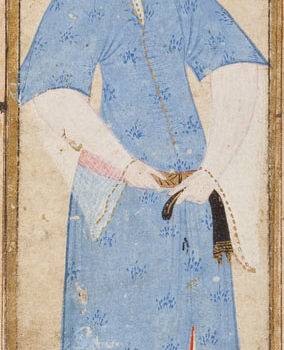Both men and women wear hip-length overcoats, usually short-sleeved or sleeveless. In modern scholarship these are usually called yeleks, following the terminology of later centuries. It’s unclear whether the 16th-century Ottoman Turks also called them yeleks, or whether they had other terms that haven’t been identified yet.
Continue reading
Is the jacket worn over the belt, or under the belt? If the jacket is worn over the belt, it’s one of those lovely garments that we don’t have a name for, the Hip-Length Overjacket. If the jacket is worn under the belt, is it worn by a man, or…
Continue reading
The yelek is a hip-length jacket that men wore over their gomlek and zıbın and under their belt and overcoat as a formal layer. It was a less cumbersome, less fabric-intensive, and therefore less high-status replacement for the kaftan. Soldiers, cooks, baristas, porters, and other men who worked with their…
Continue reading
“Hırka” was one of several names for a short, loose jacket worn by dervishes. The word appears to be post-period. Due to the vast, roiling confusion over the word for the hip-length underjacket, some modern scholars appropriated “hırka” to describe it. The correct 16th-century term is zıbın.
Continue reading
The entari, the Turkish pronunciation of the Greek anteri, was not a period garment at all. The term was barely mentioned in Istanbul-area court records until the 1630’s or 1640’s, when it appeared in addition to–not as a replacement for–other words. And when we can pin down which garment it…
Continue reading
The zıbın was a hip-length jacket that both men and women wore over their gömleks and under their kaftans. It was an informal layer, always covered in public by one of the formal robes (a kaftan for women, and a kaftan, yelek, or knee-length robe for men). Women, who spent most…
Continue reading
It’s easy to miss the hanging sleeves of the classic Ottoman overcoat. There were no sleeveless long coats in period. Alternatively, if the robe is worn by a woman, it’s the 18th-century incarnation of the kürdiye. The kürdiye was introduced at the end of the 16th century, and for the next…
Continue reading
This style of overcoat, with its conspicuous consumption expressed through fabric-intensive vestigial sleeves, was the most fashionable, most formal, and most high-status of the overcoats. Made in the finest brocades and velvets with a broad, decorative collar, it was the hil’at, the grand court overrobe. Made in less showy materials,…
Continue reading

The kaftan was a full-length robe with short, long, or extra-long sleeves, worn over the gomlek and zibin and under the belt and overcoat. It was the only formal layer women wore, and the most formal of men’s options–the suit jacket of the Ottoman world.
Continue reading
We know the names of plenty of Ottoman Turkish garments, but what did they look like?
Continue reading




